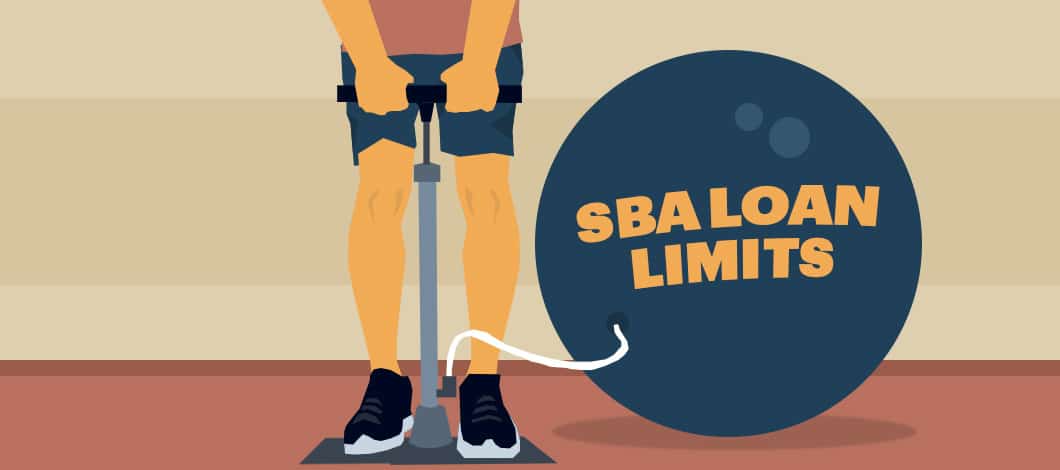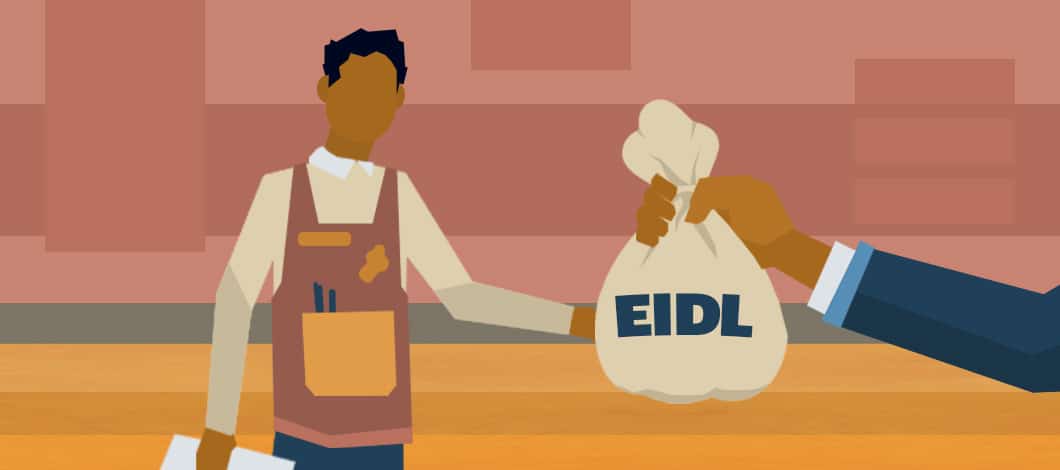Small Business Administration (SBA) loan limits for the Economic Injury Disaster Loan (EIDL) program have been increased to $500,000.
Learn how the update affects business loan opportunities.
What Are the Highlights of the SBA Loan Update?
The latest updates to the COVID-19 EIDL program announced by the SBA increase both loan limits and the length of time covered by loans. Previously, loans were limited to $150,000 and covered 6 months of economic injury. Loan limits will now be increased to $500,000 and cover 18 months of economic injury.
Businesses that qualified for a loan under previous limits will be contacted by the SBA with details about requesting increases. New applicants will be considered for loans under the new limits.
Related Update on EIDL Payment Deferment
This update follows a previous announcement that the deferment period for first payments on EIDLs and other SBA disaster loans for small businesses is being extended until March 31, 2022. Previously, the EIDL deferment period had been extended through March 31, 2021.
To move all payments to 2022, the SBA is extending the due date for first payments for disaster loans approved in 2020 to 24 months after the note date. For loans approved in 2021, the first payment date will be extended to 18 months.
How Does the COVID SBA Disaster Loan Program Work?
The COVID-19 EIDL program is part of the SBA’s broader disaster loan program, designed to help businesses recover from declared disasters such as hurricanes, fires or civil unrest. COVID-19 EIDLs are intended to help small businesses, nonprofits and smaller agricultural businesses that have suffered significant economic injury because of the pandemic. The purpose of the loan program is to help businesses cover operating expenses and financial obligations which could have been met if the pandemic had not occurred.
For loans approved starting the week of April 6, 2021, the new SBA disaster loan maximum of $500,000 covering 24 weeks of economic injury applies. Collateral is required for loans over $25,000. A personal guarantee is required for loans of more than $20,000.
Loans can be used to cover working capital and normal operating expenses. For example, a business could use a COVID-19 EIDL to pay for continued health-care benefits or fixed debt payments.
Loans are extended at 3.75% interest for businesses and 2.75% for nonprofits. Terms are available up to 30 years. First payments are deferred 18 months. Interest accrues during the deferral period. Borrowers can make payments at any time with no prepayment penalty or fees.
EIDLs are generally not forgivable, except for loans extended under the Targeted EIDL Advance program, which is not currently granting new funds.

What Can I Use COVID-19 EIDL Funds For?
You can use COVID-19 EIDLs to pay for working capital and normal operating expenses. Examples of eligible expenses specifically mentioned by the SBA include:
- Fixed debt obligations
- Continued health-care coverage
- Rent
- Utilities
This is not a comprehensive list, but some examples to illustrate allowed expense categories. SBA guidance on EIDLs in general lists other examples not specific to COVID-19 EIDLs. For instance, if a business has to hire and train a new employee to replace an essential employee lost because of a disaster, this would be an acceptable use of EIDL funds. This might apply if you have an essential employee who can’t return to work because of the effects of the pandemic.
To take another scenario, if a business can’t move inventory because of a disaster, frozen inventory expenses can be covered by EIDL funds. Inability to collect accounts receivable would be another example of a potentially covered expense.
Note that expenses you intend to pay with COVID-19 EIDL funds must fall into the allowable time frame. Under the new update, an 18-month period is covered.
Prohibited Uses of EIDL Funds
EIDLs also have standard prohibited uses, not specific to COVID-19 EIDLs. These prohibited uses include:
- Payments of bonuses or dividends
- Disbursements not directly related to performance of services to owners, partners, directors, officers or stockholders
- Repayment of loans from stockholders or principals, except when the loans were extended because of the disaster and nonpayment would cause the lender undue hardship
- Repairing or replacing physical damages
- Expanding facilities or acquiring fixed assets
- Relocating
- Refinancing long-term debts
- Repaying loans provided by other federal agencies
- Repaying federal debts other than obligations to the Internal Revenue Service (IRS)
- Paying legal penalties
- Contractor malfeasance
If you’re not sure about whether you can use EIDL funds for an expense, talk to your lender, an SBA representative or a qualified attorney.
Who’s Eligible for COVID SBA Disaster Loans?
To qualify for COVID-19 EIDLs, organizations must be located within the U.S. or its territories and must have suffered working capital losses because of the pandemic, according to the SBA. Eligible categories of applicants include:
- Businesses with 500 or fewer employees or with a number of employees conforming to industry-specific size standards defined by the SBA
- Cooperatives with 500 employees or less
- Sole proprietorships and independent contractors
- Faith-based organizations
- Most nonprofits
Eligibility includes agricultural businesses with 500 employees or less. This encompasses businesses involved in the production of food or fiber, livestock breeders, ranchers, aquaculture companies and all other farming and agricultural industries.
Can I Request Additional Funds If I Already Have an EIDL?
Yes. Loans of less than $500,000 approved before April 7, 2021, are generally eligible for additional funds under the new EIDL SBA loan maximum. The SBA is currently reaching out to prior borrowers via email with details on how to request additional funds. Emails will be sent from addresses with @sba.gov or @updates.sba.gov.
Applicants who accepted a loan smaller than the full amount offered can request additional funds up to 2 years after the date of the loan promissory note. Additional funds can be requested even after the application deadline, set for Dec. 31, 2021.

Can I Apply for a COVID-19 EIDL Funding If I Already Have a PPP Loan?
Yes. The PPP loan program, designed to help businesses affected by the pandemic cover payroll costs, is separate from the COVID-19 EIDL program — and borrowers can apply for both.
However, you can’t use funds from both programs for the same purpose.
If I Run More Than One Business, Can I Apply for More Than One COVID-19 EIDL?
Yes. You can apply once for each business you run which falls into a category eligible for COVID-19 EIDLs.
At least 81% ownership for each company must be accounted for on your application form.
How Do I Apply for an EIDL COVID-19 Funding?
The SBA COVID-19 EIDL application process consists of 4 steps:
- Apply for a loan at disasterloanassistance.sba.gov
- Receive a loan quote estimating the maximum amount you may be eligible for
- Wait for your application to be reviewed by a loan officer, who will check for completeness and contact you if more details are needed
- Receive a decision about whether your loan application was accepted or declined
If your loan application is accepted, you will receive an email inviting you to choose your loan amount up to your eligible maximum and to sign loan documents. You should download a copy of these documents for your records. Loan funds will then be transferred to your bank account within 5 to 10 business days.
You can pay your loan back through an online portal or by mail. Keep all receipts and contracts for loan funds for 3 years.
What Are Some Reasons the Loan Might Be Declined?
There are a number of common reasons why COVID-19 EIDL applications are rejected. These include:
- Low credit scores
- Unverifiable information and failure to respond within 7 days to loan officer requests for additional information
- Ineligible business activity
- Ineligible citizenship status
- Lack of evidence of economic injury
- Felony convictions within the past 5 years or other character concerns
- Failure to respond to requests for additional information or invitations to sign documents within 60 days
If your application has been declined because you failed to respond to attempts to verify information within 7 days, you may request reconsideration.
What’s the Deadline to Apply?
The application deadline and the covered period for economic injury have been extended to Dec. 31, 2021. Applications submitted before that date which are being reconsidered or resized for larger amounts will continue to be processed after the deadline.
If your application has been declined, you can request reconsideration up to 6 months after the deadline.
Consider an EIDL as You Weigh Financing Options
Most small businesses with 500 or fewer employees which have suffered working capital losses because of the pandemic are eligible to apply for COVID EIDL funding. If you’re eligible and you need cash, consider applying for an EIDL.
You may be eligible for other SBA loans and other financing options as well. To see your loan options, take a few minutes to fill out our no-obligation online application form and we’ll let you know immediately what financing resources may be available to you.










